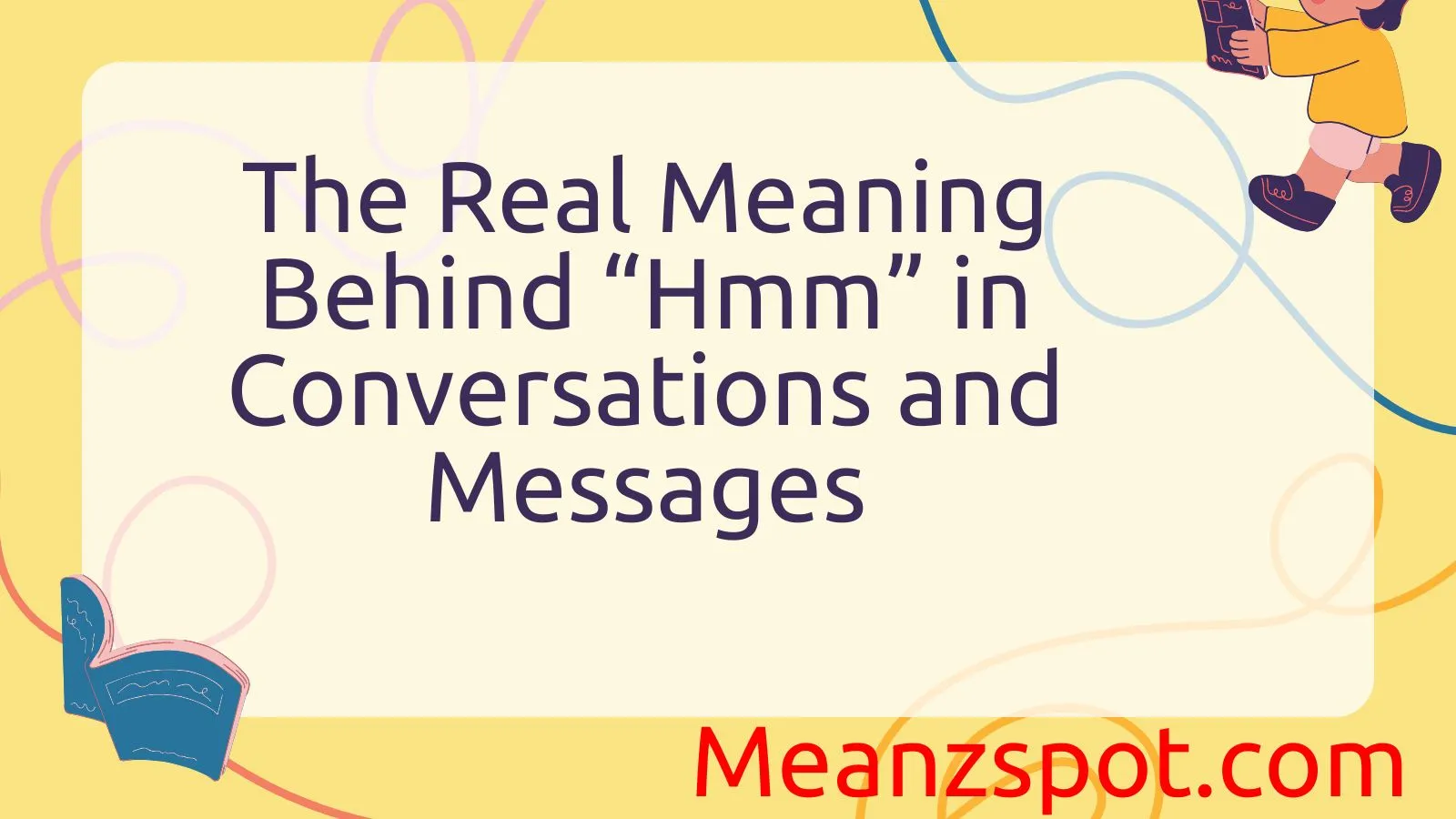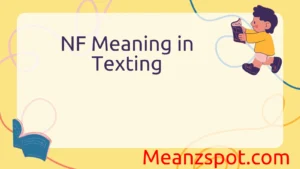Ever received a text that simply says “Hmm” and wondered what it really meant? You’re not alone. In today’s world of instant messaging and emoji culture, short expressions like “Hmm” carry big emotions—from curiosity to doubt, from passive-aggressiveness to deep thought.
The truth is, “Hmm” isn’t just filler—it’s a loaded response that depends heavily on tone, timing, and relationship. With more people communicating through text than ever before, especially on platforms like WhatsApp, Instagram, and Snapchat, decoding these tiny words has become essential for understanding intent.
Whether someone’s thinking, judging, questioning, or just trying to keep the convo going, “Hmm” can speak volumes without saying much at all. This article unpacks the hidden meanings behind “Hmm”, its emotional layers, and how to respond wisely when you receive it. Let’s decode what your friend, crush, or coworker might really be saying.
Definitions & Meaning
At its core, “hmm” is an interjection — a non-verbal sound that expresses thought, reflection, or hesitation. In written text, “hmm” serves as a placeholder for a pause or moment of contemplation. It often indicates that the person is thinking something over or is unsure how to respond.
Here are some common meanings of “hmm” in text:
- Thinking or considering: “Hmm, I’m not sure what to say.”
- Uncertainty or indecisiveness: “Hmm, maybe we could try that.”
- Mild disagreement or skepticism: “Hmm, I don’t know if that’s true.”
- Curiosity or interest: “Hmm, tell me more about that.”
- Boredom or disinterest: “Hmm… okay.”
The interpretation of “hmm” can vary significantly depending on punctuation, length, and tone. For example:
- “Hmm.” with a period might sound final or dismissive.
- “Hmmm…” with multiple m’s and ellipses could show deeper thinking.
- “Hmm?” turns it into a questioning tone, suggesting confusion or a need for clarification.
Understanding these subtle cues helps decode what’s truly being said beneath the surface of this common expression.
Origins & History
The expression “hmm” has roots in spoken language, originating as a vocalized filler used in conversation to indicate thought or uncertainty. It is classified as a paralinguistic vocalization, meaning it doesn’t have a specific definition like a regular word, but it carries meaning through its sound and context.
Historically, people have used “hmm” or similar sounds in conversation for centuries. Linguists believe it’s a universal expression, appearing in many different languages and cultures. It mimics the natural sounds people make when thinking, doubting, or hesitating — much like “uh,” “um,” or “er.”
The transition from speech to text came with the rise of digital communication — emails, SMS, and instant messaging. As texting became a primary form of communication, people began transcribing their vocal tics and conversational pauses into written form. “Hmm” found a natural place in text, becoming a shorthand way to replicate the sound and sentiment of someone lost in thought.
With the evolution of texting and the rise of online chats, “hmm” also became more nuanced. It gained emotional weight and flexibility, allowing it to represent a wide range of reactions without the need for full sentences. Its simplicity made it a go-to expression in casual conversations, while its ambiguity made it a powerful tool for subtle communication.
Usage in Different Contexts
1. Social Media:
On platforms like Facebook, Instagram, or Twitter, “hmm” is often used to express skepticism, surprise, or reflective agreement. For example:
- Comment: “Aliens built the pyramids!”
- Response: “Hmm… that’s one theory.”
Here, “hmm” expresses doubt without being confrontational.
2. Text Messages with Friends:
In casual chats, “hmm” can be a placeholder for deeper thought or indecision:
- Friend: “Wanna go hiking this weekend?”
- You: “Hmm, let me check my schedule.”
This indicates you’re interested but not immediately sure.
3. Romantic or Emotional Conversations:
In emotionally sensitive conversations, “hmm” can signal hesitation or emotional conflict:
- Partner: “Do you still want to be with me?”
- Response: “Hmm… I don’t know.”
This can be interpreted as avoidance or a struggle to answer honestly.
4. Professional Settings:
In workplace chats, “hmm” should be used carefully, as it may come across as vague or indecisive. However, when used appropriately, it can express careful consideration:
- Colleague: “Should we launch the campaign early?”
- Response: “Hmm, that’s an idea worth exploring.”
5. Pop Culture & Memes:
“Hmmm” has become a meme-worthy expression, often used humorously to depict deep (but often fake) contemplation. Images or GIFs of people rubbing their chin with the caption “hmm” are common online.
Each of these examples highlights how context changes the meaning and impact of a simple expression like “hmm.” The tone, relationship, and situation all play major roles in how it’s interpreted.
Common Misunderstandings & Clarifications
Despite its popularity, “hmm” is one of the most misunderstood expressions in digital communication. Its ambiguity often leads to confusion or misinterpretation, especially in emotionally charged conversations.
Here are a few common misconceptions and clarifications:
- “Hmm” means disapproval.
Not always. While it can suggest doubt or skepticism, it can also simply mean the person is thinking or doesn’t have a clear opinion yet. - “Hmm” means the person is upset.
Not necessarily. Some interpret “hmm” as passive-aggressive silence, but it often reflects uncertainty or delay in forming a response. - Length changes meaning.
Yes — “Hmm,” “Hmmm,” and “Hmmmm” can all carry different weights. The more m’s, the more thoughtful or hesitant the tone. - It’s rude or dismissive.
It can be if used in isolation or with a curt tone. But when paired with thoughtful context, it signals openness to discussion. - “Hmm” equals boredom.
Sometimes — if used repeatedly or with no follow-up, it might imply disinterest. However, it’s often just a thinking pause.
Understanding these nuances can help avoid unnecessary tension in conversations and ensure your “hmm” is received as intended.
Alternatives & Synonyms
If you’re looking for other ways to express similar sentiments without using “hmm,” here are some effective alternatives, each with slightly different shades of meaning:
- “Interesting…” – Suggests thoughtful engagement or surprise.
- “Let me think about that.” – More explicit version of reflection.
- “I’m not sure.” – Direct expression of uncertainty.
- “Well…” – Implies hesitation or a lead-in to a more detailed thought.
- “That’s a good point.” – Shows reflection and potential agreement.
- “You might be right.” – Suggests openness to another perspective.
- “I’ll need to consider that.” – Formal and polite, especially in professional contexts.
- “Possibly.” / “Maybe.” – Ambiguous yet thoughtful responses.
- Emoji equivalents: 🤔, 😕, or 🧐 – Used in modern texting to replace or support “hmm.”
Choosing the right alternative depends on your tone, the relationship with the recipient, and the platform you’re using. While “hmm” works well in casual settings, more explicit responses are often better suited to professional or emotionally sensitive conversations.
Frequently Asked Questions
1. Is “hmm” rude in texting?
Not inherently. It depends on tone and context. In some situations, it can feel dismissive, but usually it indicates thoughtfulness or hesitation.
2. What does a long “hmmmmmm” mean?
A longer version often implies deeper thinking, uncertainty, or being lost in thought. It can also be playful or dramatic depending on tone.
3. Can “hmm” mean yes or no?
Sometimes. It’s often used when the person hasn’t made a decision yet. It’s not a definitive yes or no but suggests they’re leaning toward one.
4. Should I use “hmm” in professional messages?
Use with caution. It can appear vague or indecisive. It’s better to be more direct in formal communication, like saying, “That’s worth considering.”
5. Why do people reply with only “hmm”?
This might mean they’re thinking, unsure how to respond, or trying to be noncommittal. It can also reflect disinterest, depending on context.
6. What’s the difference between “hmm” and “um”?
“Hmm” suggests contemplation or uncertainty in opinion. “Um” is more often used to fill a pause when speaking or as a placeholder while forming words.
7. How should I respond to “hmm”?
You can follow up by asking for clarification: “What do you mean?” or “What are you thinking?” This encourages a more open response.
Conclusion
Though it may seem like just a few letters, “hmm” carries a surprising amount of meaning in text communication. From expressing deep thought to signaling hesitation or skepticism, its power lies in its ambiguity. Understanding the nuances of “hmm” — how it’s used, where it comes from, and what it can mean — can help prevent misunderstandings and improve how you interact digitally.
Next time you see or type “hmm,” take a moment to consider its context and possible interpretations. Sometimes, the most subtle expressions speak the loudest — and in the digital world, “hmm” is one of them.



